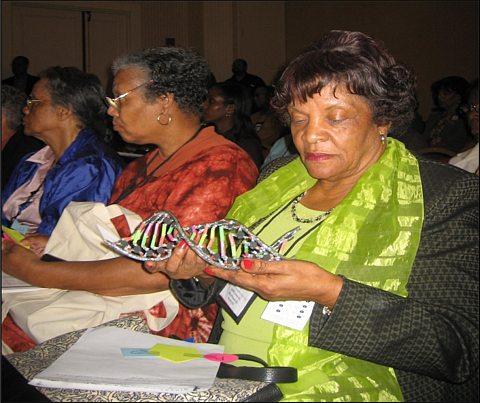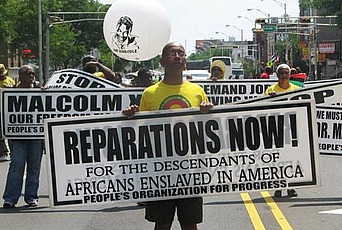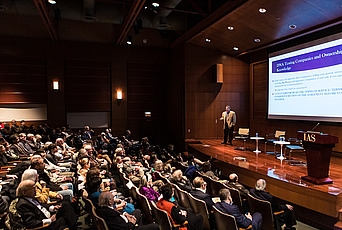The Social Life of DNA

Like many Americans, my family and I were riveted by the Roots miniseries when it first aired in January 1977. I vividly recall sitting in front of the television with my mother, father, sister, and two brothers, watching the story of Alex Haley’s family unfold in Technicolor.
My father, having just completed a tour at sea, reclined in an armchair, his feet up. My mother was on the sofa with one or two of us kids twined tightly around her. The other two of us were on the floor, alternately being admonished by our parents not to lie too close to the screen or told, courtesy of a sibling, to move out of the way. On Sunday evening, when it became apparent that we would view the first episode in its entirety—well past our bedtimes—we knew we were in uncharted territory.
The Roots occasion provided one of those unforgettable moments when a child sees her parents in a new light. Watching Roots, I also watched my parents, who were visibly stirred by Haley’s account. More than a few times during those eight evenings, my mother’s eyes welled with tears. She frequently shook her head and murmured “Uhm-uhm-uhm,” as I had heard Mary, her Philadelphia-born mother, do many times. An inherited response for emotions that defy language, perhaps. My father, who hailed from New Orleans, was characteristically stoic, but occasionally allowed a “That’s a damn shame” during an especially graphic or tragic scene. I realize now that while watching Roots, my parents similarly watched us, their children. They were worried and protective, interspersing their own commentary between scenes, hoping to ameliorate the dramatic effect of this painful history.
The Roots effect expanded beyond our family home, perched on the edge of a craggy San Diego canyon, to my grade school, nestled in a valley. I was called Kizzy and Kunta Kinte by my mostly blond classmates during first period at my Southern California private school. But during our lunch breaks, the teasing gave way to earnest but clumsy conversations. In the schoolyard, we tried to make sense of what Roots meant for our interracial friendships, for our discussions in Sister Nora’s American history class, and for our nation in the wake of its bicentennial. In our own ways, we each wondered: Who are we in relation to this history? Did this really happen? If so, how did we get from then to now—and where do we go from here?
Haley made his mark as a collaborator on The Autobiography of Malcolm X, the late activist’s influential account of his political transformation published in 1965. This work emerged at the beginning of the black power era. Roots, published in 1976, and the television miniseries that was based on it, which premiered a year later, were culminating symbols of the era. This was the time of the Afro and the dashiki—of the “Black is beautiful” ethos. Between 1965 and 1977, black Americans turned to their African origins with intensity.
This interest in African origins and, in turn, genealogy, was piqued in 1977. This watershed year also saw the publication of Black Genealogy by Charles L. Blockson, a primer of root-seeking attuned to the needs of African Americans, who faced especially steep hurdles in tracing ancestry. The Afro-American Historical and Genealogical Society (AAHGS), the first national black organization dedicated to genealogy and family history, was also established in 1977. In the intervening decades, genealogy only grew in appeal for African Americans. In the last decade, with the decoding of the human genome, new tools were introduced that expanded the popularity of genealogy exponentially and, moreover, gave it multifaceted uses.
I began research for The Social Life of DNA in 2003 after noting mention in the press of a DNA testing service that promised to help blacks trace their roots. I was captivated. At that time, genetic ancestry testing was in its infancy and traditional gatherings of genealogists were where the early adopters of these new root-seeking techniques could be found. I attended scores of these gatherings, large and small, throughout the country, from Oakland, California, to Bedford, Massachusetts, and numerous places in between. My travels also took me to the United Kingdom. In these places, I encountered genealogists who had been using archives and oral history to reconstruct their family stories and who were willing to try the new genetic-ancestry-testing services that were just hitting the market.

Building a bridge to Africa has inspired black American arts, letters, and politics for generations. Even if these speculative “roots” tests I read about never materialized, here a cutting-edge answer was being proposed to a central enigma of African America—a remedy that seemed ripped from the pages of a sci-fi novel. Speculation soon gave way to the news that a black geneticist named Rick A. Kittles had launched African Ancestry with his business partner, Gina Paige. Among the earliest direct-to-consumer testing companies in the United States, it was the first niche-marketed to people of African descent. As an ethnographer and historian of African America, with a special interest in science and technology—as befitting a child born from the union of a cryptographer and a mechanical technician—I knew that I had to join Kittles on this journey.
I used what social scientists call “snowball sampling” when conducting my interviews with root-seekers. In other words, I interviewed genealogists about their decision to use genetic ancestry -testing and the effects of the results on their lives, and they, in turn, referred me to others. As I would discover, what was snowballing was not only the number of people in my interview network, but the surprising ways the test results were being put to use. That is, I was also being given an unexpected map of how genetic information was being used by individuals, communities, and institutions. Yes, personal and family information was gleaned. But in these conversations, there was also growing mention of how broadly genetic ancestry testing was being used as the industry evolved. For over a decade, I’ve followed Kittles and African Ancestry, and in this time, have come to take a long view of genetic ancestry testing, a perspective that is more mosaic than the predictable, ritualized scenes of revelation and surprise we have become accustomed to witnessing on popular genealogy television shows.
As a wide-eyed girl watching Roots, and wondering about mine, I never could have dreamed a future where one day I’d have the surreal experience of having my genealogical results revealed to me before a crowd of African diaspora VIPs and civil rights leaders, and with a prominent actor, Isaiah Washington, as master of ceremonies. Although this -experience elicited mixed emotions in me, I can personally attest that new branches on ancestral trees are the undeniable graft of genetic genealogy.
The Social Life of DNA unearths what else we try to accomplish with these tests, including political and legal uses. I’ve found this might include establishing ties with African ancestral homelands, transforming citizenship, recasting history, or making the case for reparations which, as we know, is an issue that is once again part of our national conversation. I describe these lesser-known but truly momentous uses of genetic ancestry testing as “reconciliation projects,” endeavors in which genetic analysis is placed at the center of social unification efforts. These may be legal attempts to financially reconcile formerly opposed parties like the descendants of enslaved persons and the current-day companies that profited from slavery, such as Aetna, JP Morgan Chase, and Wachovia. Reconciliation projects are also efforts to reunite formerly unified parties like blacks in the United States seeking to reconnect with lost kin and community in Africa. They may also be used to reestablish biographical or historical information that has been lost to the march of time or to settle contentious issues. In short, these DNA-based techniques are offering a new tool to examine long-standing issues, and these reconciliation projects reveal manifold and potentially transformative possibilities.
The Social Life of DNA tells the compelling, unexpected, and still-unfolding story of how genetics came to rest at the center of our collective conversation about the troubled history of race in America. I hope you will join me on this foray into an extraordinary, uncharted arena of twenty-first-century racial politics.
The summer of 2010 marked the tenth anniversary of the decoding of the “first draft” of the human genome. This scientific milestone was met with cautious appraisal from usually enthusiastic quarters. Leading science reporter Nicholas Wade bemoaned in the New York Times that “after 10 years of effort” the therapeutic promise of genomics “remains largely elusive.” J. Craig Venter, the maverick geneticist who was a major force behind the Human Genome Project, declared more emphatically in Der Spiegel that “we have learned nothing from the genome.” These sober assessments were surprising given how profoundly our social world has been changed by genetic science and its applications in the last decade.
While concrete health benefits stemming from the Human Genome Project may indeed be “elusive,” its broader impacts are clear. Genetic analysis has become widespread. There is no question that genetics research is prevalent in biomedicine, even if its ability to predict or remedy ills remains to be fully demonstrated. In criminal justice settings, DNA is becoming ubiquitous and is double-edged, playing a role in both conviction and exoneration. And commercially available genetic tests that claim to specify genealogy, ancestral affiliation, or racial and ethnic identity are among the most conspicuous signposts of our genome age. In these different institutional settings, we have zealously (and often uncritically) seized upon DNA as a master key that unlocks many secrets.
DNA is the ultimate big data. Genetic data is multivocal and contains information that can be used in varied facets of society regardless of its source or its original intent of use. And genes are omnibus; they confer many types of information simultaneously. DNA analysis therefore moves across and between the expected medical, forensic, and genealogical domains, and also beyond them into a wider set of arenas, with expanded purpose. Diverse ends and aspirations are now sought with and through the use of genetics. This diffusion comprises the social life of DNA.
This social-life approach to genetics follows the methodology of the anthropologist Arjun Appadurai, who, in The Social Life of Things, argues that to understand what objects mean and why they are important we must trace their circulation in society (“things-in-motion”), illuminating “their human and social context” and revealing “the human transactions and calculations that enliven things.” By similarly tracking DNA analysis, we gain insight into where and why genetics is called upon to answer fundamental questions about human existence, often through extensions of its popular genealogical uses. Genetics is today engaged in practices of identity formation, in philanthropy and socioeconomic development projects, as corroborating evidence in civil litigation and historical debates, and elsewhere. Thus, although the therapeutic utility of the genome may be arguable, the social life of DNA is unmistakable: the double helix now lies at the center of some of the most significant issues of our time.
In light of African Ancestry’s burgeoning business, what does the use of genetics in the context of long-standing cultural aspirations and political struggles suggest about the prospects for racial reconciliation in the United States? Activist groups and NGOs—including some, like the Leon Sullivan Foundation, with direct ties to the late-twentieth-century civil rights movement, and others, like the Descendants of the African Burial Ground, that carry the march toward racial justice forward into the twenty-first century—are turning to genetics to accomplish goals formerly pursued through grassroots organizing, electoral politics, and moral suasion. Laments about the decline of the civil rights activist tradition may thus be misplaced. Activism is simply taking new forms, in line with the scientific and technological innovations of the last decade, as the social media campaigns that sparked national protests against police brutality in Jena, Louisiana; Ferguson, Missouri; Baltimore, Maryland; and at other sites in recent years make clear. And given cautionary observations about the lack of participation of minorities in science and technology and these same communities’ traditional (and well-founded) mistrust of these and related fields, the embrace of genetics for liberatory ends is particularly striking.
However, efforts to reclaim original identity through genetic technologies, while psychically beneficial, fail to materially address persistent structural inequality. In the same way that the scientific and therapeutic applications of DNA research may not yet have fully lived up to expectations, the application of genetic technologies to reconciliation initiatives brings their technical, institutional, and political limits into stark relief. The trajectory of the reconciliation projects discussed in The Social Life of DNA suggests that ultimately, equality, justice, and ethics are not easily tethered to or readily settled with DNA evidence.
We should worry that, with their reliance on commercial products, well-intentioned, innovative uses of genetic genealogy might contribute to a world in which claims for citizenship are tied to practices of consumption. And we should worry mightily about the transposition of the principles of justice into scientific techniques. But we should also appreciate that these endeavors are an innovative strategy on the part of some who find other avenues to historical awareness and social justice blocked, and who pursue the road to racial reconciliation nevertheless.


